Every feature of intelligence or learning aspects in principle can be so precisely described that a machine can seamlessly simulate it. – John McCarthy
John McCarthy, who is the Father of Artificial Intelligence, was a pioneer in the fields of AI. He not only is credited to be the founder of AI, but also one who coined the term Artificial Intelligence.
In 1955, John McCarthy coined the term Artificial Intelligence, which he proposed in the famous Dartmouth conference in 1956. This conference attended by 10-computer scientists, saw McCarthy explore ways in which machines can learn and reason like humans.
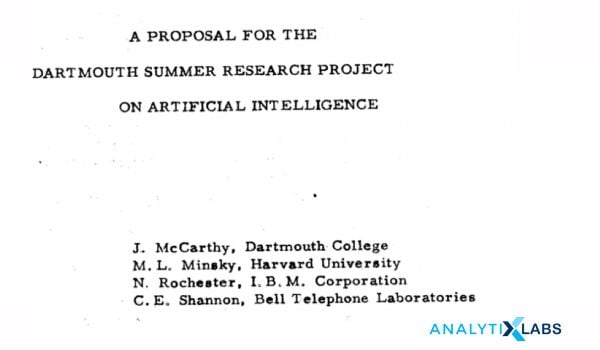
He believed in developing machines that will embody the abstract-thinking and problem-solving nature of human brains i.e. a machine can be made to simulate the learning aspects of a human.
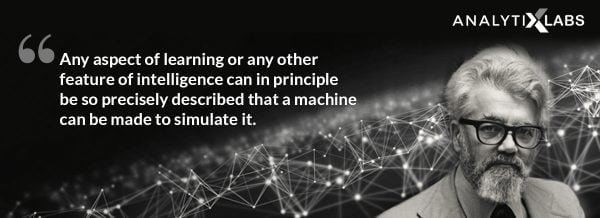
At the age of 84, who is the founder of artificial intelligence, John McCarthy left the world on October 24th, 2011. A professor and an inventor, John McCarthy defined and dominated the field of AI for over five decades.
Knowing the Father of Artificial Intelligence – John McCarthy
John McCarthy, an acclaimed computer science giant and a seminal figure in AI was born in Boston in 1927. Eventually, he with his parents moved to Los Angeles. A bright mind from a young age despite being ill, he secured an undergraduate place at California Institute of Technology. He graduated in 1948. The idea of inventing a technology that could help machines learn did not happen out of the blue.
John McCarthy happened to attend a symposium on ‘Cerebral Mechanisms in behaviour‘. It was from here that his quest to create machines that could think as humans began.
John McCarthy’s Major Achievements in AI
John McCarthy’s coining of the term Artificial Intelligence laid down the roadmap for artificial intelligence to become a field of study. He was later joined by Marvin Minsky at MIT in 1959 where McCarthy was a research fellow.
Following his quest to build machines that could mimic human logical thinking, his next breakthrough came when he proposed the Advice Taker in 1958 in his paper ‘Programs with Common Sense‘. This hypothetical computer program sought to use logic to represent information in a computer. This was also the first step in introducing the concept of using logical reasoning to enhance artificial intelligence.
In the same timeline, McCarthy went on to invent a new programming language – LISP, which is still used as the choicest language in the field of AI. John McCarthy also turned eyes with his mind-boggling concept of time-sharing sometime between the 1950s and 1960s. One might as much say his concept of using one central computer to store everything and sharing across multiple systems was like a stepping stone for our present-day cloud-based storage.
Three major earliest time-sharing systems are largely credited to John McCarthy –
- Compatible Time-sharing System
- BBN Time-sharing system
- Dartmouth Time-Sharing System
Le Earnest, his colleague at that time, had exclaimed that the internet wouldn’t have happened that soon if it were not for John McCarthy’s invention of time-sharing systems. He said how with time, new names for this came up – namely servers, and then with time, cloud computing.
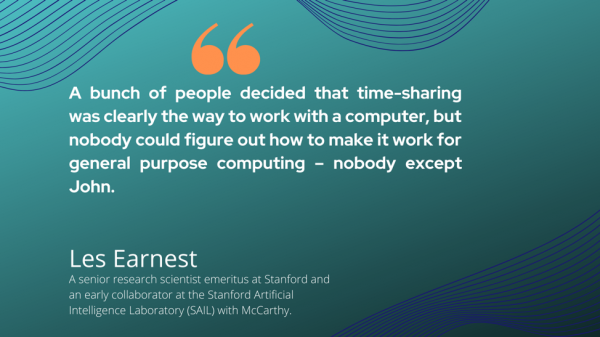
John McCarthy went on to become a distinguished member of the ACM Ad hoc Committee on Languages, International Federation for Information Processing (IFIP). Around 1959, McCarthy invented, what is also called, the ‘garbage collection‘ method in order to solve problems in Lisp. This method attempted in claiming memory that was occupied by objects and was not being used by the program. His invention made way to simplify manual memory management in Lisp.
In 1961, the idea of utility computing came into being. John McCarthy, in his speech at MIT’s centennial, mentioned this idea. The concept of using selling specific applications through a utility business model (like electricity or water) was pretty popular in the late 1960s but faded away by the mid-1990s. However, this same idea sprung back to life sometime in 2000 in new forms of cloud computing, grid computing, and application service provider.
As years rolled by, in 1966, McCarthy and his team participated in a chess game with counterparts in Soviet using a computer program to play the game – losing two games and drawing two.
McCarthy spent his time in developing the circumscription method of non-monotonic reasoning sometime between 1978 to 1986. Circumscription, as hard the term sounds, was actually a method of formalizing the common-sense assumption of things as expected unless specified otherwise.
Meanwhile, in 1982, news surfaced about his new idea of Space Fountain – an idea that denoted that a long tower would extend into space and be kept vertical by the outward force of a stream of pallets emitted from the earth along with a sort of conveyer belt that will bring back these pallets to earth.
Throughout his journey, his contributions to the field of artificial intelligence are impeccable. His contributions were recognized globally and were awarded many-a-times. Some of the notable awards to his name are:
- Turing Award from Association for Computing Machinery in 1971.
- Kyoto Prize in 1988.
- National Medal of Science (USA) in Statistical, Computational Sciences and Mathematics in 1990.
- Benjamin Franklin Medal in Cognitive Science and Computers from the Franklin Institute in 2003.
In 2012, the founder of Artificial Intelligence was named as one the Stanford Engineering Heroes.
While John McCarthy remains the farther of artificial intelligence, the field of AI saw many more leaders whose contributions are noteworthy.
Let’s learn about some of these distinguished leaders.
Related Blogs:
1. What is Applied AI?
2. 101 of Artificial Intelligence – What is Know as a Beginner? 3. Artificial Intelligence Tutorial – Guide For Beginners
Other Leaders In The Field of AI
While the father of AI, John McCarthy is the torchbearer, there are many more names that have made AI what it is today.
1. Noam Chomsky
If John McCarthy is credited as the founder of artificial intelligence and one who coined the term Artificial Intelligence, Noam Chomsky raised a red flag for forgetting artificial methodologies and simultaneously discussed what went wrong with AI.
A professor and a researcher of Linguistics and Cognitive Science, Noam Chomsky spent 50 years at MIT earning the title of ‘Father of Modern Linguists‘.
McCarthy’s optimism with his concept of AI slowly brought in puzzlement and also garnered Chomsky’s skepticism. Chomsky’s ideas and theories were more rooted in the cognitive behaviour of humans. His contributions in the realm of cognitive psychology and philosophies of language and mind accelerated and helped thrive the ‘cognitive revolution’.
Noam Chomsky, while addressing one of the most critical questions of AI – can cognition be created – weighed in on AI. His approach was Statistical Big Data – an approach that uses mathematics intensively to sift through a huge amount of data and recognize complex patterns.
2. Geoffrey Hinton
Geoffrey Hinton is another torchbearer in the field of artificial intelligence. He is known for his contributions to artificial neural networks. He joined Google (Google Brain) in 2013, and in 2017 he co-founded Vector Institute of Toronto, where he is also the Chief Advisor.
He is deemed as a pioneer in fields of deep learning and is often referred to as the Godfather of Deep Learning. His work includes in-depth research in exploring ways to use neural networks for machine learning, perception, and symbol processing. Hinton’s early fascination with the human brain left many puzzled about its possibility in computers. The idea of implementing neural networks to design complex computer structures was conceived with positivity but the complications seemed far too challenging. However, Geoffrey Hinton, the genius that he was, maintained his confidence. In his interview with the Wired, he goes on to explain why –
I don’t seem to think that there is any other way in which a brain may work. This is the only way – it has to learn the strengths of connections. And if you want to build a device that will replicate this nature of the brain, then you have two ways to do it – either you can program it, or you let it learn by itself. As far as I know, people weren’t programmed, so we did learn. So this is the right way to do it. [Quotes transcribed]
His idea was never to replicate how the brain works. It was always to look at what the brain understands and how it works in certain situations; then using this finding to design a machine that can think like that. That’s how he drew the neural connections.
3. Marvin Minsky
Marvin Minsky was the amalgamation of a philosopher searching for truth and a scientist with a gamut of knowledge. His work inspired the creation of personal computers and the internet. He holds the credit of laying down the foundation stone for exploring possibilities of imparting common-sense reasoning to computers in the field of AI.
His research began with understanding human psychology and computing ideas that could characterize the complex human thinking. Just like the father of AI, John McCarthy, Marvin Minsky also found human intelligence and thinking fascinating and mysterious. And why not, since he was also a colleague to John McCarthy at M.I.T. Artificial Intelligence Project.
However, Professor Minsky’s contributions to the field of AI spanned across multiple disciplines. Here’s some of them –
- He designed the first visual scanner.
- He also created mechanical hands with tactical sensors.
- He built Snark, the first wired neural network learning machine.
- Lastly, at Harvard, he invented the first confocal scanning microscope with superior resolution and image quality.
Like his colleague, John McCarthy, Professor Minsky was also awarded the prestigious Turning Award in 1969.
The field of artificial intelligence also saw many other leaders like Allen Newell, Ray Kurzweil, Andrew Ng, Yann LeCun and more.
All these leaders and their contributions steadily put Artificial Intelligence onto the radar – a field of study that became more prominent with time. Their contributions led to countless inventions in the field of artificial intelligence.
Major Inventions of Artificial Intelligence
While we have already traced the history learning about the minds behind AI, let’s look forward to some of the major inventions of AI.
1. Virtual Agents
Virtual Agents or chatbots is definitely one of the finest inventions of AI. It is a form of language that enables bots to communicate ideas with perfect accuracy. For instance, those automated chat conversations you have on a brand’s website is a classic implementation of NLP.
You know its a chatbot but you will never quite feel it to be. The perfection with which the bot interacts with you, trying to resolve your issue or addressing your query – is exactly what AI has achieved. Check this automated conversation implemented by MobileMonkey on their Facebook Messenger for someone wanting to sign up.
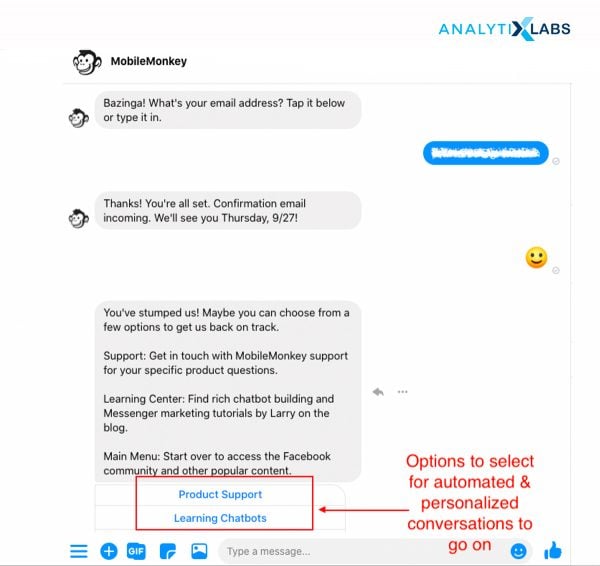
The same kind of approach is also used on Websites to capture visitor details or help solve customer queries. For instance, on AnalytixLabs, we have ALabs Smart Bot for help.
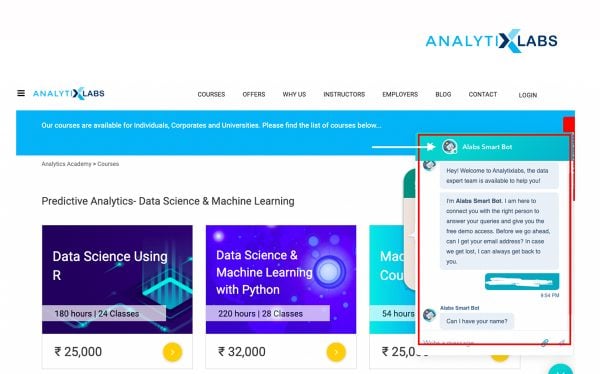
2. Natural Language Generation
This is a sub-discipline under AI and helps in converting data into texts. It helps computers interpret and present data in the form of human-readable texts with perfection. Examples would be customer service reports and market summaries. Take for instance this report by Automated Insights –

This is an example of using NLG in a BI dashboard to provide a narrative summary. Automate Insights’s Wordsmith NLG platform is integrated with Tableau and other BI platforms to help analysts generate such comprehensive reports.
Related: Want to work with BI platforms? Learn Tableau and Data Visualization.
3. Machine Learning Platforms
Another major invention of artificial intelligence is machine learning platforms. Machine Learning or ML is a branch of AI and is designed to help computers learn.
We see the implementation of machine learning regularly now. With proper algorithms, API interfaces, big data tools, and other related resources, Machine Learning is gaining momentum more than ever. One classic example that we all see every day happens in Amazon.
Amazon uses machine learning to predict and classify its customers, products and buying patterns. For instance, automated recommendation emails from Amazon is a classic use case of machine learning. Or, when you are on the home page of Amazon (and signed in) you will see “products recommended” based on your previous browsing. This prediction comes through machine learning wherein the machine “learns” what you might like by going over your past browsing, and predicts your buying pattern.

Related: Want to learn Machine Learning? Check out the course details here.
4. Cyber Defense
Let’s just say, in today’s age and time, this has to be one crucial invention from the field of AI. Cyber Defense is a computerized defense mechanism that concentrates on preventing attacks, give timely warnings, and provide in-prompt responses in case there is an attack or threat to the information and infrastructure.
This puts into use both AI and ML to create a hostile environment for attackers. Research shows that almost 4.1. Billion data was compromised in the first half of 2019 itself – highlighting the high risks that we are living in and the boon that this invention of AI is.
For instance, startup Darktrace, a self-learning Cyber AI, works in this field by pairing behavioral analysis and advanced mathematics to detect behaviors that are out of the norm inside an organization. They apply AI algorithms to detect malware and mitigate damages.

In Conclusion
The implementation of artificial intelligence is happening everywhere, in every industry. There is no other better way to sum this up than stating that AI is the present and future of the world.
Looking back at the world’s greatest minds in AI, it is obvious we also have to look ahead in how AI is evolving to make machine learning simpler. Be it your Alexa or Siri, Google’s map, or your marketing automation tool – there is AI in everything you see, hear, and touch.
This is the most fruitful time to get started with it. And whoever told you about expensive degree courses, surely haven’t considered learning at your own comfort. Start with professional and on-point Applied AI courses on AnalytixLabs and follow the footsteps of AI-leaders who have nothing but inspired us day-in-and-out.
You may also like to read:
1. How to Become an AI Engineer? Know about Skills, Role & Salary
2. Artificial Intelligence Tutorial – A beginners Guide
3. Artificial Intelligence Future – Machine Learning

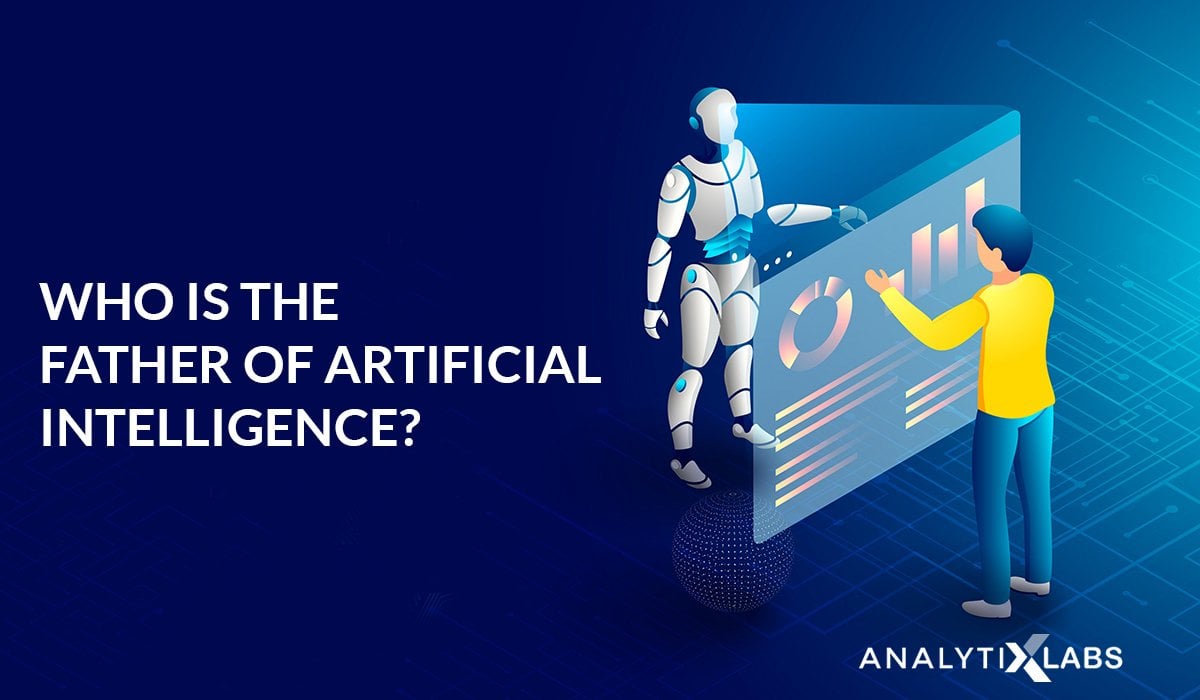







1 Comment
Nice you want a new and fresh post on artificial intelligence VS human intelligence